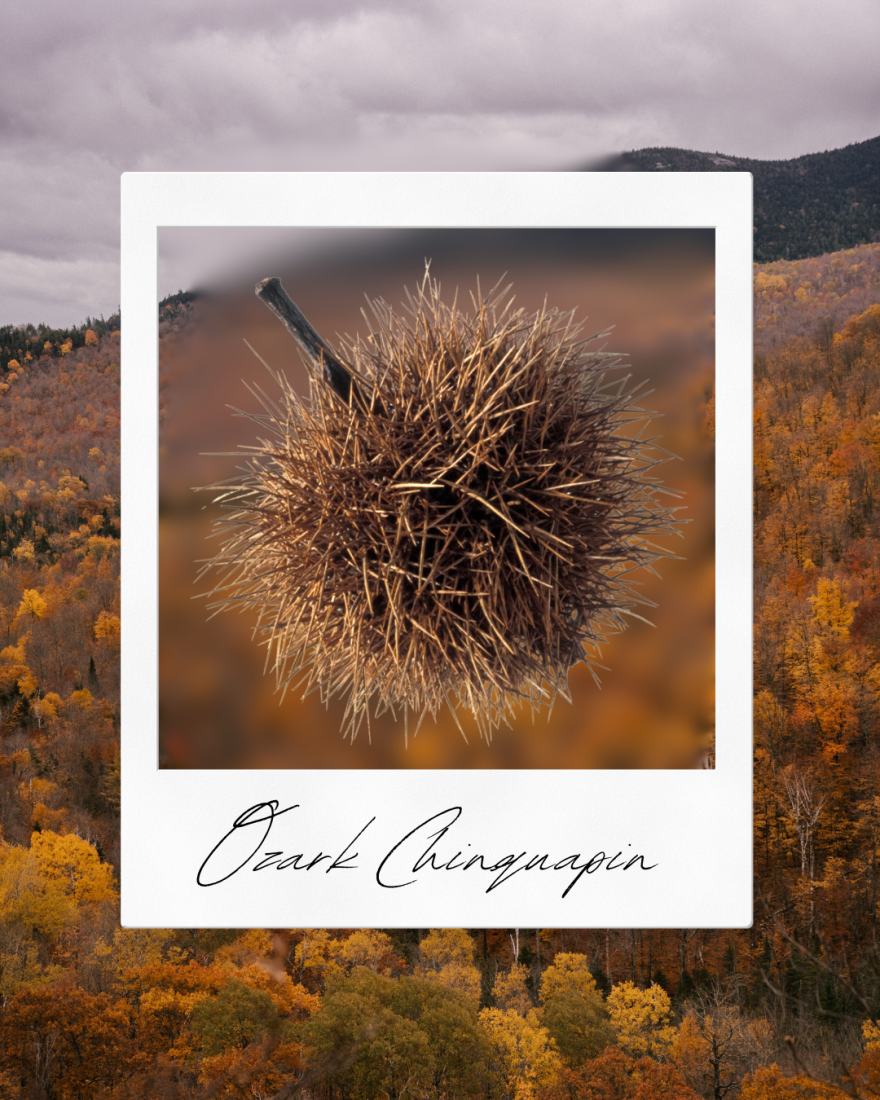Chinquapins! Or as some say, Chinkapins. Have you heard of them?
It is a word one seldom hears any more, although at one time, it meant the very essence of November.
Also known as a dwarf chestnut, its fruit is half the size of the fruit of the nearly extinct American chestnut tree, and less than half as susceptible to the blight that killed off nearly all the big trees. And it tastes better! I know this because we used to pick them, my family and I, every November from a grove of trees hiding out on the far reaches of my uncle’s farm. It was before the blight had found them here, but they were highly prized, and their locations, like those of the morels today, were closely guarded. Only because we were family were we allowed in on the secret.
I remember those treks into the deep woods well. The trees were beautiful, tall, lanky fellows, reminiscent of the young ents in Tolkien’s stories. And their fruits were abundant, little clusters of burrs, very like the larger chestnuts’ outer husks, but more the size of hazelnuts.
Now before you ask, it’s true that the chinquapin and the hazelnut look similar to the naked eye. But looks are deceiving. The chinquapin and the chestnut are both members of the beech family, while the hazelnut’s family members are all birches. And while the chinquapin variety that grows in the Ozarks has close cousins found all over the southeastern United States, ours is endemic to the Ozarks, as its scientific name, Castanea ozarkensis, would indicate. The Ozarks chinquapin once was common and widespread, all over the Ozarks, and was, in places, the dominant species, especially in the Interior Highlands of the Ozarks, in the deep woods. Some specimens have also been found in parts of Texas, Louisiana, Mississippi, Georgia, Alabama and adjacent states all the way up to Virginia and the Carolinas. Meaning, it either once had a much larger range, or it was carried there by people who loved it.
In its heyday, the trees often grew large enough to be harvested for lumber. But that was before the blight. It’s true - the Ozarks chinquapin was found to be more resistant to the blight than the American chestnut, which was virtually wiped out by the introduced fungus. But not much more. Most of the big trees are gone now, replaced by small thickets of shrubs likely growing from the old tree roots. Many of those bear the canker scars of the fungus’ passing. But they still bear fruit, and it’s said to be just as sweet. And there are some trees that survived. And the sprouts from those trees show more immunity from the blight than do their Chinese cousins. So, there may come a day, probably long after I’m gone, when the Ozarks chinquapin and its fruits are plentiful again. There certainly seems to be a significant effort being put into making that happen. Witness the Ozark Chinquapin Foundation, where blight resistant seeds and small tree seedlings are available. Based in Western Grove, Arkansas, you can look them up on Google or contact them at ozarkchinquapininfo@gmail.com for more information.
Just think, plant a few chinquapin seeds or seedlings, and one day you may be marking your November calendar with time to harvest Chinquapins, whether you say chinquapin, chink-a-pin, or as one dear old gentleman calls them, chickey-pens. I can’t offer you any recipes, for I never knew anybody to use them in a recipe. We just ate them out of hand, with very few making it all the way home except those saved for Granny Gentry, who had no lower teeth and so wrapped the shelled nuts in a paper sack and pounded them into a paste with a hammer and declared them “right fit to eat.” It was high praise for an Ozarks treasure. Ask your folks if they remember where any might be. Look them up so you’ll know them when you see them. Go find some. Try ‘em.
You can thank me later. Or better yet, send me a handful. Happy November.




